Initial release date 27 October 1995 Genre Puzzle video game | Series Puzzle League Publisher Nintendo | |
 | ||
Composer(s) Super NES
Masaya Kuzume
Game Boy
Masaru Tajima
Masaya Kuzume
Yuka Tsujiyoko Mode(s) Single-player, multiplayer Developers Nintendo, Intelligent Systems, Nintendo Research & Development 1 Platforms Super Nintendo Entertainment System, Game Boy, Nintendo 3DS Similar Puzzle League games, Intelligent Systems games, Puzzle video games | ||
Tetris attack game grumps vs
Tetris Attack is a 1995 puzzle video game developed by Intelligent Systems and published by Nintendo for the Super Nintendo Entertainment System and Game Boy. It is the first game in the Puzzle League series. While it was originally known in Japan as Panel de Pon (パネルでポン Paneru de Pon) for the Super Famicom and featured different art assets and characters, its English localization was replaced with characters from Super Mario World 2: Yoshi's Island. It was released on the Game Boy under the same name. The Game Boy release of the Yoshi version was also later released in Japan. On November 3, 1996, a version was released for the Super Famicom's Satellaview satellite modem service as BS Yoshi's Panepon (BSヨッシーのパネポン, Bī Esu Yosshī no Panepon). This game is similar to the Baku Baku Animal, developed by Sega in 1995.
Contents
- Tetris attack game grumps vs
- Snes classics tetris attack super hard mode full gameplay
- Plot
- Gameplay
- Panel de Pon
- Newer versions
- Reception
- References
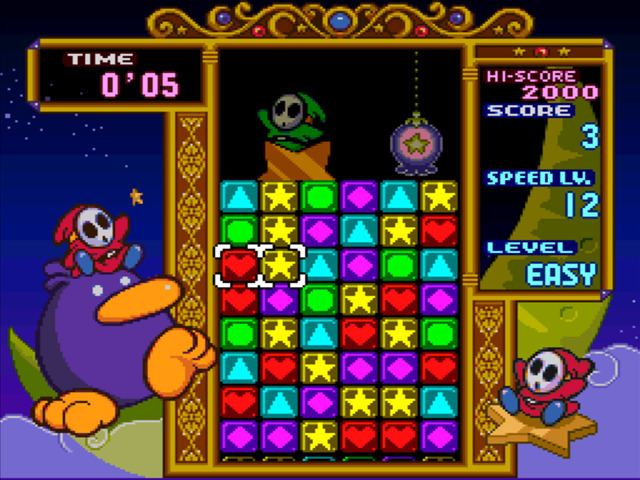
Despite using the Tetris name, this game has no resemblance to its Russian namesake. This has led Henk Rogers of The Tetris Company to say that he regrets granting permission to Nintendo to use the name.
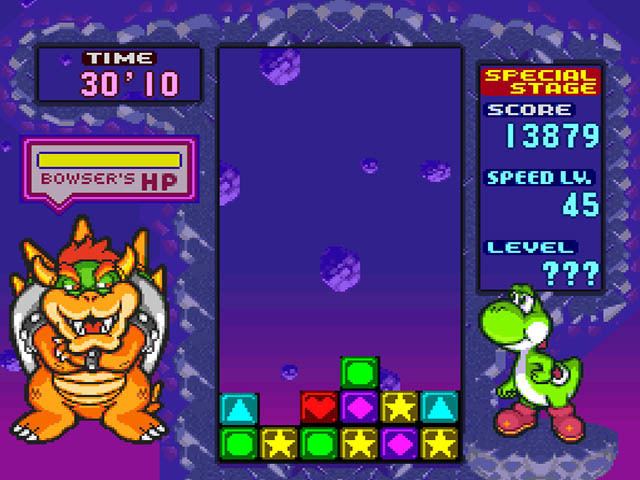
Snes classics tetris attack super hard mode full gameplay
Plot
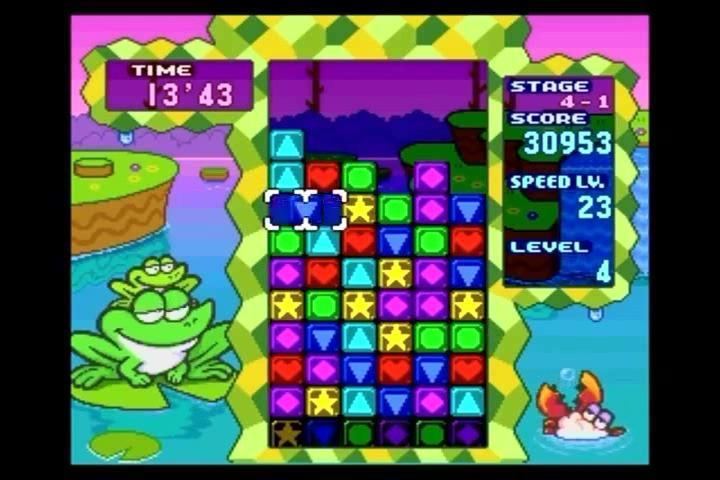
The game's single-player story mode takes place in the world of Yoshi's Island, where Bowser and his minions have cursed all of Yoshi's friends. Playing as Yoshi, the player must defeat each of his friends in order to remove the curse. Once all friends have been freed, the game proceeds to a series of Bowser's minions, and then to Bowser himself. During these final matches, the player can select Yoshi or any of his friends to play out the stage.
Gameplay
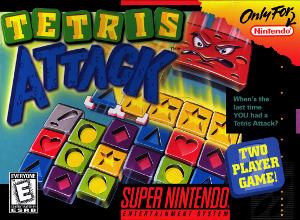
In Tetris Attack, the player is presented with a playfield consisting of a virtual grid of squares, each of which can be occupied by a colored block. Blocks are stacked on top of one another and rise steadily toward the top of the playfield, with new blocks being added at the bottom. The player must arrange blocks in horizontal or vertical lines of three or more matching colors by swapping blocks horizontally two at a time. As matching lines are formed, the blocks are cleared from the screen and any blocks above them fall into the gaps. The game is over when the blocks touch the top of the playfield, or another game-ending condition is met (such as reaching a time limit or clearing blocks below a set line).

Clearing more than three tiles in a single move scores a Combo, while Chains are scored when falling blocks from one clear cause another clear to occur. Both of these events score extra bonus points, and in multiplayer Versus games, these also send "garbage blocks" to the other player's playfield.
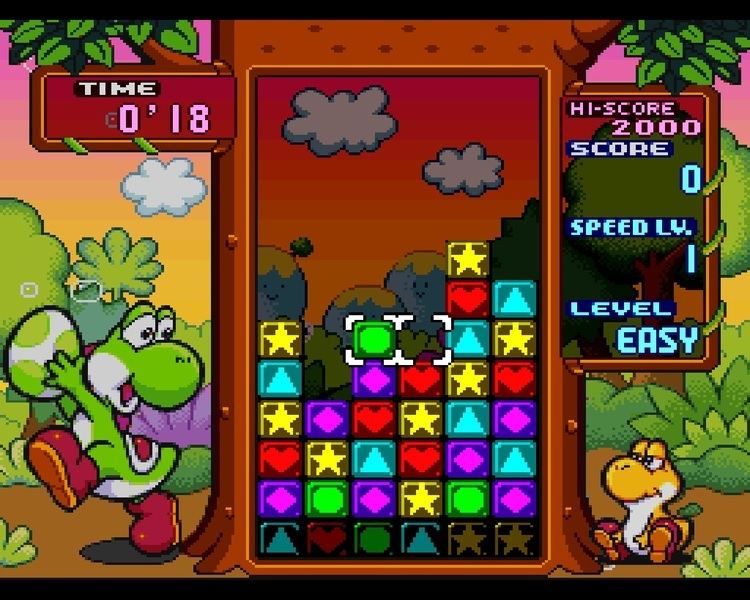
Tetris Attack provides several single-player modes. Story Mode takes the player through the game's main plot, pitting the player against a series of foes in a head-to-head match. The objective is to cause the computer-controlled player to lose. In Endless Mode, the player is challenged to play as long as possible with a continuously rising stack of blocks, which increases in speed over time. Timed Mode challenges the player to score as many points as possible within a two-minute time limit, and Stage Clear mode takes the player through a series of stages in which the objective is to clear blocks below a set line. A Puzzle Mode is also provided, which presents the player with a number of puzzles where he or she must clear all of the blocks in a set number of moves (Blocks do not rise in this mode).
In addition to the game's single-player modes, Tetris Attack also provides several multiplayer modes that are essentially two-player variants of the single-player modes. One or both human players may be substituted with a computer-controlled player with a selectable difficulty level.
In the main story mode, there are six different endings, obtained through the difficulty setting. Ending E is obtained from beating Easy mode, Ending D is obtained by beating Normal mode, Ending C is obtained by beating Hard mode, but dying at least one time, Ending B is obtained from beating Hard mode without dying, Ending A is obtained by beating Very Hard mode, but dying at least one time, and Ending S is obtained from beating Very Hard mode without dying, the latter being the hardest and best ending of the game. The only thing that changes is the final Headlines and cutscenes.
Panel de Pon
Tetris Attack was originally released as Panel de Pon which was released on October 27, 1995 in Japan. An altered version of the original Panel de Pon was also released via Satellaview in 1998 under the name BS Panel De Pon - Event '98. The original Panel de Pon was released in Japan on the Wii's Virtual Console service on November 27, 2007. Tetris Attack's gameplay remains the same but the characters were changed from Panel de Pon's original characters to characters based on Super Mario World 2: Yoshi's Island.
In Panel de Pon, the evil devil king Thanatos has cast a spell over the world of Popples to cause fighting amongst the fairies. The Fairy of Flowers, Lip, is unaffected due to her magic stick. Lip must defeat each of her fairy friends in a puzzle game to return their personalities to normal, then proceed to face off against Thanatos. Upon completion of Hard Mode, the player discovers that the final boss, the goddess Cordelia, is actually Lip's mother and queen of the fairies. She informs Lip that the events leading up to this moment were a test to see if Lip had the strength to become the new Queen of the next generation of fairies.
In the version of Panel de Pon released as part of Nintendo Puzzle Collection for the GameCube, similar but younger fairies take the place of the original characters, and several new characters and stages have been added. The plot is otherwise very similar; however, the ending is very different. Other changes include a password system and improved AI over Panel de Pon. While it uses some new tracks based on Yoshi's Island, all of the in-game music in Tetris Attack remains unchanged from Panel de Pon except for the track Cordelia X which is absent. The original Panel de Pon soundtrack was scored by Masaya Kuzume. The music tracks from Yoshi's Island were arranged by Fire Emblem composer Yuka Tsujiyoko. The demo theme is "Lip's Theme", which would later be remixed for Super Smash Bros. Brawl and reused in Super Smash Bros. for Wii U.
Newer versions
The game was updated and rebranded in 2000 for the Nintendo 64 as Pokémon Puzzle League (PPL). This version, based on the first few seasons of the Pokémon anime, includes a training mode, a puzzle editor, and a 3D game mode that takes place in a cylindrical playfield. Pokémon Puzzle Challenge (PPC) was released around the same time for the Game Boy Color, retaining most of the features of PdP while introducing "Garbage Mode" and a new "Intense" difficulty level.
Panel de Pon was ported again in 2003, this time for the GameCube as part of Nintendo Puzzle Collection, released only in Japan. This version features new characters (the descendents of the original PdP characters), updated graphics and sound, and a four-player competitive mode. The game's release in North America was quietly cancelled.
An adaptation of Panel de Pon is available in the Game Boy Advance title Dr. Mario & Panel de Pon, released in Japan in 2005. This version, also released in North America as Dr. Mario & Puzzle League, contains generic graphics and background and no story mode at all, making it the first game in the series to be released on only the merits of its gameplay.
The most recent version of the game is Panel de Pon DS in Japan (Planet Puzzle League in North America, Puzzle League DS in Europe), released in 2007 for the Nintendo DS. This version includes new backgrounds and music, stylus-enabled gameplay, and the ability to play against other players worldwide via the Nintendo Wi-Fi Connection service. Aside from an unlockable background featuring Lip (from the original Panel de Pon) in the Japanese version, the DS version continues the storyless presentation of the Game Boy Advance title. A limited-function version, known as Chotto Panel de Pon in Japan, Puzzle League Express in North America, and A Little Bit Of Puzzle League in Europe, was released for the Nintendo DSi via the DSiWare service on the Nintendo DSi Shop. This version includes most of the original release's single-player features, and excludes multi-player gameplay entirely.
Reception
Tetris Attack was met with very positive reviews, earning a 90% average rating on GameRankings. GamesRadar listed it 87th on their list of "The 100 best games of all time", stating "you haven't lived until you've played Tetris Attack two-player and dropped an immensely satisfying five line garbage block on your opponent." Game Informer featured it on its own best games of all-time list at 96 and called it one of the most addictive puzzle games made.
